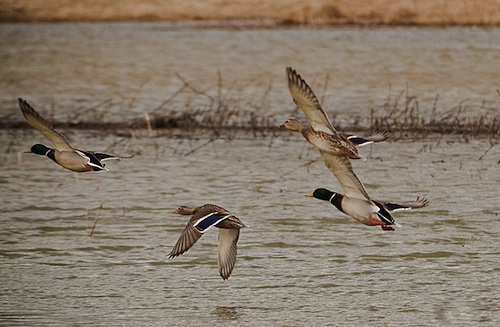While waterfowl seasons across the nation are beginning to come to an end, the opportunities for photographing waterfowl are just starting to heat up. I often find that my best waterfowl images come after the season ends when the ducks, geese, and swans have settled down a bit and are not so stressed from migration and avoiding hunters. Some of my best images have come in February, March and April – not months traditionally thought of as peak waterfowl season. Mating and breeding waterfowl can offer some excellent photographic opportunities as their colors, plumage and behaviors are all at a peak.
Learn to listen to and watch large groups closely, soon you will be able to predict their actions by behavior and the various calls they make. While a single image of a green head in flight is dramatic, do not underestimate the impact that an image of hundreds or thousands of migrators lifting off the water can make.
The proper equipment is a must when photographing waterfowl on the wing. Good images can be obtained using a quality 70-300mm lens, especially when used on cropped sensor body, but I find that my 400mm lens is truly my go to lens for waterfowl. That extra bit of reach is often necessary.
 Unlike other forms wildlife photography, a tripod is just not practical in any sense when it comes to photographing water fowl. Tripods don’t fit in blinds and pits. They sink and fall over in marshes, they are ungainly and difficult to handle when quick movements are needed. Instead of using a tripod, shoot with your camera much the way you would with your gun when hunting waterfowl – deep breath, pull it up, lead the shot and start banging away. It goes without saying that if your camera has an option for a burst of images this what you want to select. Get comfortable with panning. Keep your shoulders and head tight in position, and twist from the waist as you follow the bird across its flight path.
Unlike other forms wildlife photography, a tripod is just not practical in any sense when it comes to photographing water fowl. Tripods don’t fit in blinds and pits. They sink and fall over in marshes, they are ungainly and difficult to handle when quick movements are needed. Instead of using a tripod, shoot with your camera much the way you would with your gun when hunting waterfowl – deep breath, pull it up, lead the shot and start banging away. It goes without saying that if your camera has an option for a burst of images this what you want to select. Get comfortable with panning. Keep your shoulders and head tight in position, and twist from the waist as you follow the bird across its flight path.
When shooting waterfowl using your cameras predictive focus is nearly a must – as is using aperture priority. A word about aperture in this case – resist the temptation to use a wide open aperture. Although the best shooting times for waterfowl coincide with low light conditions, you will find that the images are much sharper if you determine your lenses sweet spot. Typically this is 2 stops above its wide open setting. For instance since at 400mm f/5.6 is wide open on my lens, I’ll bump it to f8, maybe even f/11 if the light is improving. In order to obtain the necessary shutter speeds that needed for sharply capturing a bird in flight, change up the ISO vs. changing the aperture. Most higher end DSLRs now produce excellent image quality at ISOs of 1600 and some at 3200. The higher ISO will allow you to shoot in that sweet pre dawn hour without sacrificing quality.
 Position yourself correctly for the “in your face shots.” Waterfowlers, and waterfowl lovers, want to see those birds dropping in, wings cupped, landing gear down. It’s important to understand that for the best images you need the sun and the wind at your back for those. Waterfowl land INTO the wind. If the wind is howling in your face, you will most likely end up with a memory card full of ducks behinds. With the sun behind you, it will assist in lighting up the bird as it comes in.
Position yourself correctly for the “in your face shots.” Waterfowlers, and waterfowl lovers, want to see those birds dropping in, wings cupped, landing gear down. It’s important to understand that for the best images you need the sun and the wind at your back for those. Waterfowl land INTO the wind. If the wind is howling in your face, you will most likely end up with a memory card full of ducks behinds. With the sun behind you, it will assist in lighting up the bird as it comes in.
If you are new to photographing waterfowl, I would suggest finding a park or refuge with a fairly stable population of birds and practice on those before stepping off into the fields, marshes and rivers in search of the wild birds. These birds are often a bit more tolerant of people and will allow you work a little more slowly than those in the wild.
Soon our feathered friends will begin the migration back to their summer breeding grounds, offering you some great opportunities. Extend your waterfowl season by getting out there and trying your hand “wing shooting” with a camera!
See more of Gretchen Steele’s photography at her website.
Wow, Gretchen, what a great start to my day reading your article and seeing the photos! You have definitely inspired me to get out there and try my skills at camera wingshooting! The photographs are INCREDIBLE!!!
Great article and great photos as always Gretchen.. thank you
Thanks Ladies! Tammy any time you want to try and meet up for a day “in the middle” let me know.. we’ll find some birds and we can both practice! 🙂